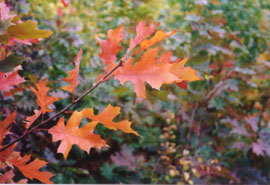Did You Know...
The Northern red oak grows up to 100 feet tall, making it one of the largest tree species in New Jersey. In Warren County near the Musconetcong River grows the biggest Northern red oak on record in the state with a circumference of 20 feet, 1 inch.
The red oak is a good choice for a street tree because it resists the salt used on roads and sidewalks. The introduced species Gypsy moth threatens our state tree. A single caterpillar can defoliate one square foot of leaf area per day.
Black oak Quercus velutina and Northern red oak Quercus rubra have similar leaves, bark, and height. However, the inner bark of the Black oak is orange, and Northern red oak’s inner bark is white. The red oak’s acorn is larger with a flat cap, while Black oak’s acorn has a “helmet” cap. The Northern red oak has a broad range extending from Nova Scotia to North Carolina. Native Americans ground the acorns of the red oak with other types of acorns to make a flour used for food.
The Northern red oak is nicknamed the “mighty” oak for its strong, deep root system.
Northern red oak acorns mature in two years.
Acorns of the red oak taste bitter, so many animals prefer the more tasty types of acorns to eat, leaving the red oak acorns to germinate.
|


